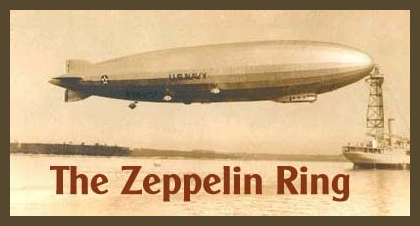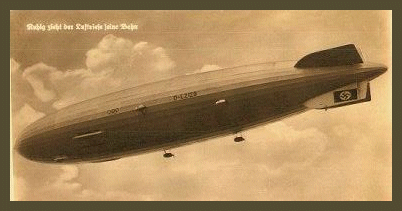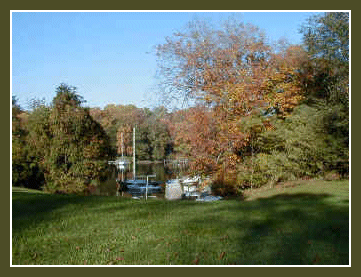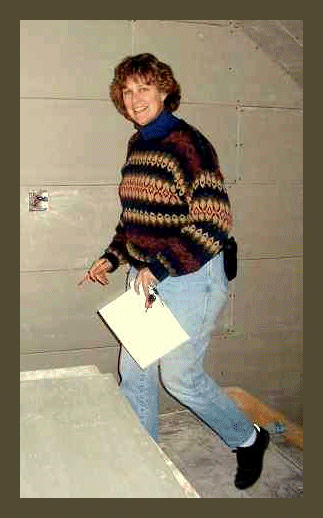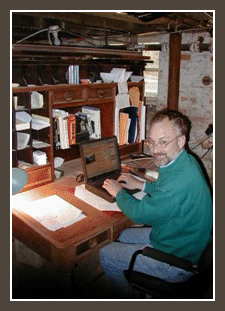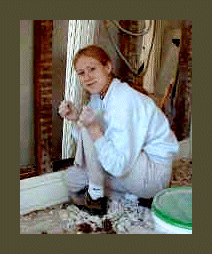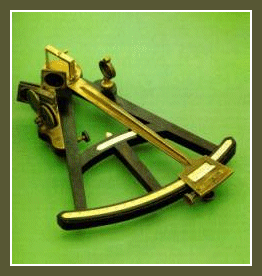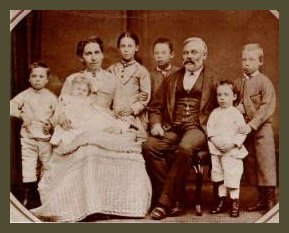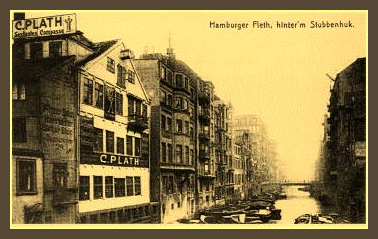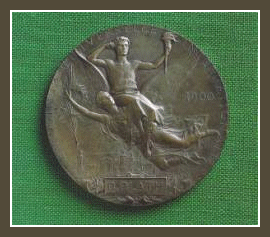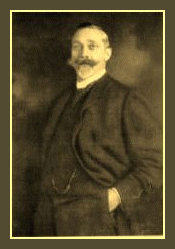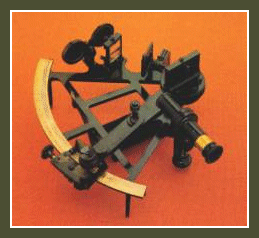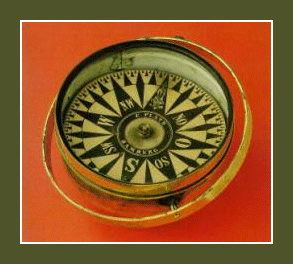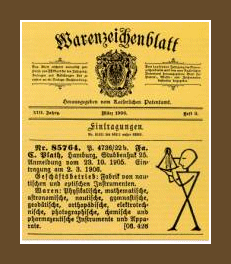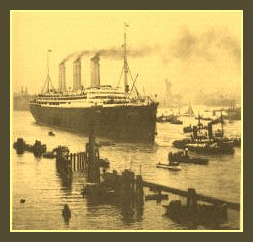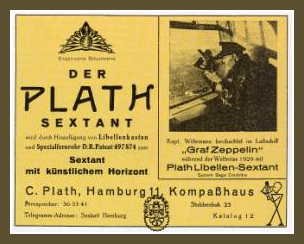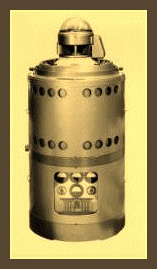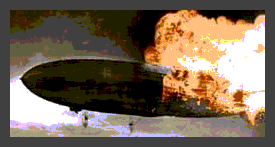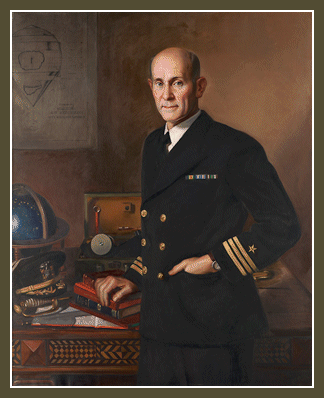
The
Thirties began a period of revolutionary changes in navigation.
Foremost among those responsible for these improvements is
Captain Philip Van Horn Weems, U.S. Navy (Retired). Weems, born in 1889
and orphaned as a child, grew up on a Tennessee farm, with his six
brothers and one sister worked themselves after their widowed mother
died. In 1908, after a year at a prep school, he
entered the U.S. Naval Academy, where he sailed on the last cruise of
the Navy’s square-rigged sailing ship Hartford. During his
student days he began his love affair with the stars which lasted the
rest of his life. After he graduated in 1912, he
specialized in navigation, especially celestial navigation, practicing
it at sea and instructing midshipmen in Annapolis classrooms.
When
Weems first used his “hambone” sextant aboard the ships of the
pre-World-War-I fleet, he used the American Nautical Almanac, which
still contained tables for the solution of longitude by means of lunar
distances. First published in 1757, these tables
allowed navigators to calculate their longitude even without an
accurate chronometer, but the observations were so difficult, and the
method of reducing the observations so complicated and lengthy, that
Weems had never met a navigator who knew a navigator who ever made
practical use of the technique.
The
Nautical Almanac still tabulated the positions of the heavenly bodies
using hours and minutes of Right Ascension. Celestial
observations were still worked out by most
navigators by solving the celestial spherical triangle by means of
logarithms, the biggest improvement here during the previous century
being the adoption of the Marcq St. Hilaire azimuth
intercept method, coupled with improved haversine tables devised
by Percy L.H. Davis. (The big advantage of
haversines is that they are always positive, and obviate blunders from
giving quantities the wrong signs). Solving a
celestial sight, however, was a long process that required a lot of
arithmetic, although with eight-knot ships nobody was in much of a
hurry.
By
the time Weems had been in the navigation business for ten years,
however, he had begun to do a very un-expert-like thing -- he was
trying to simplify matters. Ordinarily, people who
become experts have a vested interest in keeping things complicated,
since this makes their expertise more valuable. Weems,
however, had begun to interest himself in aviation, and particularly
air navigation, where the ten-fold increase in speed meant that the
navigator wais always in a hurry. The old ways,
hallowed by centuries of use aboard ships, were no longer fast enough
for those who had to cope with the winds aloft.
By 1928 Weems was well enough known
in navigation circles to take a month’s leave to teach celestial
navigation to Charles A. Lindbergh, who was well known as being
the 105th man to fly the Atlantic, as well as the third man to fly it
non-stop, and the first to fly it solo. While
taking sun-sights for practice, Major Tom Lanphier, U.S. Army Air
Corps, at Selfridge Field, Michigan, pointed out the weaknesses in
transferring a sun-line ahead for an hour to get a running fix, as had
been done for decades aboard ship. This set Weems
to thinking that a fix obtained from sights on the sun and also the
moon would provide an accurate fix, the difficulty being that reducing
the moon observation was fearsomely complicated.
Weems
turned the matter over in his mind, until one morning at 4:00 AM a
partial solution occurred to him, which he forthwith suggested to the
Naval Observatory superintendent. Solving sights
involved adding or subtracting longitude, which is recorded in degrees,
from right ascension, which was then recorded in
hours (at fifteen degrees per hour). After
receiving suggestions from several other navigators, Weems in 1929 came
up with his “Lunar Ephemeris for Aviators,” which tabulated the moon’s
Greenwich Hour Angle in degrees of arc against ten minute intervals of
Greenwich mean time. This was an enormous
simplification from the practice followed by the Nautical Almanac, and
is essentially the same as that used today by the Air Almanac, and also
the Nautical Almanac (though here the periods are hourly), The
idea was so good that Weems extended it to stars, planets, and the sun,
coming up with his “Air Almanac” in 1933.
A
prophet, however, has no honor in his own country, and the Air Almanac
was discontinued in 1934. In 1936 the idea was
suggested to the British, who grasped it enthusiastically, and have
published it every year since 1937 in a book whose cover
bears a design of an Elizabethan seaman shooting the sun with a
cross-staff, together with the slogan “Man Is Not Lost.”
The
United States began publishing the American version of the Air Almanac
in 1941, and then shortly after the war the United
Kingdom and the United States began publishing it jointly. Her
Majesty’s Stationery Office, as a mark of respect to Capt. Weems,
provided him with advance copies free of charge; the United States
provides him with as many copies as he wishes to pay for. The
Nautical Almanac was also re-designed to bring it into line with the
streamlined methods which had worked out well in the air.
Meanwhile
Weems was progressing further in his endeavor to simplify celestial
navigation in the air. Working out celestial sights
by logarithms was still popular at sea, but “short” methods
were gaining favor. “Short” tables (which
air navigators paradoxically thought were long ones) short-circuited
the logarithm route by tabulating certain values (which were, indeed,
often logarithms themselves) which, when added and subtracted according
to a set of rules, arrived at a star azimuth to plot (i.e.,
the direction to look to see the star) and also a tabulated height
(i.e., the altitude at which the star would appear
if the navigation were actually located at the navigator’s assumed
position). Almost always these tables relied on the
principle that splitting any spherical triangle into two right-angle
triangles by dropping a perpendicular from the apex to one side wouldl
make the solution easier. The calculations and
table-searches for “short” tables were easier than they were when using
logarithms, but they were still rather lengthy and vulnerable to error,
especially when the navigator was in a hurry, which
he usually was aboard an aircraft. There were a
myriad of short methods, including Ageton’s, Ogura’s, Dreisonstok’s,
Smart and Shearme, and Comrie’s tables, to name only a few.
The
big advantage of short methods
were that they were usually contained in a small book. Their
chief competitor was the pre-computed table, which did all the
computational work beforehand and then tabulated the actual altitude
and azimuth for any combination of even degrees of latitude and
hour-angle, combined with the declination of the body being observed.
Examples of these tables were the British Air Navigation Tables
and HO 218, first used during the Second World War, HO
214 widely used for surface navigation, and HO 249, the simplified and
improved version published since the early
50’s. These tables were convenient and
faster than the short methods, but they required a large number of
books.
Weems
pondered the matter at length and came up with a method which depended
on the fact that circles of equal altitude (really the position-circles
which the navigator wishes to plot) ring the sub-stellar point of each
star (the point on the earth’s surface immediately beneath the star)
like the circular ripples around a stone dropped in the water.
This family of circles travels around the world at the same
speed as the rotation of the earth. The longitude
of any portion of this set of concentric circles depends on the
hour-angle of the star (i.e., the difference in longitude between
the sub-stellar point of the star and the aircraft).
Weems, with immense labor, selected a number of pairs of stars
whose families of circles intersected at convenient angles (i.e., gave
a good “cut”) and plotted them for given bands of
latitude and hour-angle. The navigator had only to
pick the right page for his latitude and longitude, observe
the two stars plus Polaris for a latitude-line, change his
Greenwich Mean Time to hour-angle, and enter the star-altitude tables
like a graph to obtain his fix.
Weems,
who had retired in 1933 with the rank of Commander, published the famous
Star-Altitude Curves, sinking most of his personal funds into
the enterprise. The Navy, however, was not too
interested. The U.S. Army Corps on the other hand
was, and gave him a small contract for his tables. Before
the war was over he had received, as the President
of Weems System of Navigation , a contract for a million dollar’s worth
-- for which he gave a discount of 80%.
Weems’
interest in Star Altitude Curves did not stop him from retaining a
concern for the more traditional methods. While he
was an instructor at the U.S. Naval Academy, he was explaining the use
of tables to determine the azimuth of a heavenly body to a class of
students. One of the students, a Lieutenant Ageton,
contended that if a set of tables could be used to compute azimuth,
which it did by solving the celestial triangle, it could be used to
solve for altitude as well. Nobody had thought of
this before. Weems encouraged the young officer,
and before long Ageton’s tables (HO 211)
were in use as possibly the most compact set of “short” tables
in existence. Getting the new concept into print,
however, was a harrowing experience; from several authorities, Weems
and Ageton received nothing but obstruction, on the ground that the old
ways were perfectly good enough.
Weems
was recalled after the outbreak of the war, as a Convoy Commodore
(the senior naval officer with a convoy, one of whose main tasks
is to keep the merchant ships from bumping into each other).
In the interim, however, he had not been idle. He
had published his epoch making book, Air
Navigation and came up
with the device which is associated most closely with his name -- the
Weems Plotter. This combination protractor,
straightedge and parallel rule has appeared in
dozens of sizes, guises and modifications, and was the standard plotter
for the U.S. Air Force.
Another
of Weems’ inventions was the second-setting watch. At
sea, celestial sights had to be taken with the aid of a hack watch
which was set to the ship’s chronometer. It was
difficult, however, to set the watch exactly, which meant that it
differed slightly from the chronometer, which in turn differed from
Greenwich Mean Time. Weems reasoned that the
difficulty in setting the watch came from the fact that at the time it
was almost impossible to set the second hand exactly. However,
if the second hand could not be set to match the dial perfectly, it
might be possible to make the dial movable, so that the dial and the
second hand were synchronized at the right time. The
fact that Weems’ father-in-law was a patent attorney helped
him considerably in getting the idea patented, but patent it
he did, and he had dozens of claims based on the second -setting watch
patent.
Weems
was also the author of the Line of Position Book which
was originally published by the United States Naval Institute, plus
some fifteen other books on the various aspects of navigation.
He, and his company, pioneered and developed a variety of
devices, including a complete celestial navigation system, a
sunset-sunrise computer, the celestial coordinator invented
by Wyatt, and a method of using altitudes
between two stars, without a visible horizon, developed by an
Australian named Burton, and Precomp Navigation, which was a super
short tabular method.
Weems
cotninued working on sea and air navigation, but
space navigation had not escaped his attention. In
1961, at the age of 72, he was recalled to service to work with four
clever ensigns to develop a system of space navigation. This
indeed they did, using Weems’ constant companion of
half a century, a sextant. During this effort,
Weems and his colleagues picked up another four or five patents.
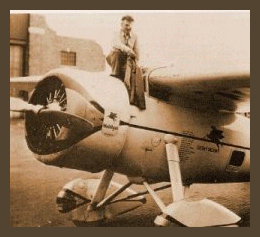
Wiley Post and the Winnie Mae
During
his career Weems met most of the great and
near-great of navigation and aviation. One of them
was Orville Wright. In his files, also, he has a
copy of an invoice for $10.00, sent to Wrong-Way Corrigan. Corrigan
always insisted that he flew the Atlantic from New York to Ireland back
in 1938 in a light plane strictly by mistake, since he planned to fly
to Los Angeles and misread his compass. However,
the invoice records that the information and charts he wanted from
Weems were all about the North Atlantic. Possibly
he studied the wrong area by mistake, also.
Weems
flew to the North Pole, when it was far from the routine
matter it is today, in 1948, and flew around the world in 1950, both
times keeping detailed and accurate logs and charts and being
intimately concerned with the navigation. He also
navigated a light plane, flown by his son, the late Cdr. George T.
Weems, USN, from London to Alice Springs in Central
Australia. In the early Thirties Admiral Richard
Byrd invited him to accompany him to the South Pole, and Weems was
sorely tempted to go, but he was about to establish
his own business, and the two years he would have had to spend in the
Antarctic would have set him back seriously. Regretfully
he declined.
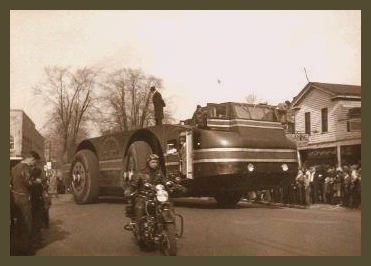
Built
for Admiral Byrd for Polar Expeditions
Weems
retired again at the end of the Second World War, but kept as busy as
ever. One of his achievements, in his spare time,
was to join with two friends of his, likewise interested in navigation,
to establish the U.S. Institute of Navigation in 1945. Because of
Weems’ reputation and knowledge, Col. Charles Blair sought him out, as
Lindbergh had done earlier, for instruction in celestial navigation
when Blair planned to fly over the North Pole, from Norway to Point
Barrow in his modified P-51 Mustang single-seat fighter in 1951.
Weems settled on a totally pre-computed
solution for Blair, which involved plotting his flight in advance, and
working out the altitude of the sun for a number of points along the
path. These sun-altitudes were then joined
to form a graph. In flight, all Blair had to do was
to take a sight and compare his observation with
the predicted altitude from the graph. The
difference between the two values indicated how for he was off track or
off schedule. Weems and Blair carried out the
computations four times, in case Blair had to delay his take-off by a
day and also to allow for having to delay the hour of take-off from
noon to one o’clock. Everything worked as planned,
with Blair not having to lay pencil to paper after he passed
Spitzbergen on the Norwegian side of the pole. He
made his landfall at Point Barrow one minute ahead of his ETA.
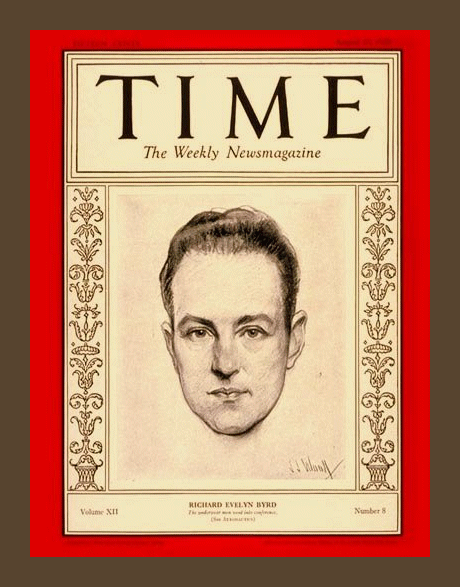
Weems,
however, overheard Blair saying, “It was nothing”, to an engineer when
queried about his navigation. “Don’t say that!”
said Weems. “That kind of navigation is still
fairly complicated, and if you tell people there’s nothing to it,
they’ll try to fly over the pole in ignorance of all the ins and outs
of celestial, and kill themselves!” Blair
agreed, and toned down his navigational modesty.
Weems
lived in Randall House, a historic 30 room building, built in 1717 and
bought by him in 1939. Its position is 38
degrees 58.8 minutes North latitude, 76 degrees 29.4 minutes West
longitude. Weems had to know this, since he
was constantly trying out new techniques which involved observing the
sun and the stars from his front porch with a marine sextant or a
bubble sextant. Visitors who were interested in the art were always
invited to take a few sights, which Weems carefully entered into the
log he kept for many years. Weems affection
for his house was not diminished by the fact that it layed exactly
eight-tenths of a minute of longitude West of the Maine Mast at the
U.S. Naval Academy, from which he graduated 57 years ago.
Weems
had several other distinctions besides his achievements in aviation.
He was on the Olympic wrestling
team in Antwerp in 1920, he was an All-American center with the Navy
football team, he won the South Atlantic amateur light-heavyweight
wrestling championship in 1925 when he was 30, he was a proficient
skin-diver and in 1959 he joined an expedition to explore Port Royal in
Jamaica, where the pirates of the Spanish Main had their capital two
centuries ago.
In
December 1968 Weems was presented with the gold John Oliver la Gorce
Medal by the National Geographic Society, in token of his life’s work
in air, sea and space navigation, rather than in appreciation of any
specific achievement. Quite a different
acknowledgment of Weems’ contribution to navigation was paid by Ben
Carlin, the author of the book Half- Safe who says:
“Of
all the professions, trades that are shrouded by their professional
practitioners in an aura of self-protective bull,
celestial navigation just about takes the cake.
‘Well
it is rather complex, old man - you wouldn’t understand - y’really need
forty years at sea for this sort of thing.’
Thanks largely to air navigators, the Hydrographic
Office of the U.S. Navy, and Commander Weems, this primeval
veil has been ripped away in recent years. It’s
not a matter of mathematical proficiency - I
can’t count to twenty with my shoes on; the fantastic ease with
which, given a modicum of elementary understanding, the correct time,
an almanac, a book of tables, a sextant and a patch of clear
sky, one can determine osition within a mile or so anywhere
on the earth’s surface, never fails to fascinate me.
Let no one interested flinch from tackling it - but on the right
lines. No, I have never
met Commander Weems or corresponded with him in any
way.”
His
life, however, has not to be unmarred by tragedy. Both
his sons met untimely deaths, Major Philip Van Horn Jr. being killed in
the Southwest Pacific in 1943, and Lt. Cmdr. George Thrackray (Weems
always referred to him as “Bee”) being killed at 30 in 1951 testing an
aircraft. Weems and his wife Margaret had a married
daughter, Margaret Dodds, who had three children.
Other
people may be impressed by Weems’ accomplishments, but Weems himself
was not. He was at all times completely
approachable, polite and pleasant. Letters to him
were always answered promptly, and sometimes in his own handwriting.
Those who met him always found him a thorough gentleman.
Captain Weems died June 2, 1979 at the age of ninety
and will always be remembered as one of the great navigators of
the Twentieth Century. In memory and in honor of
Weem’s significant contributions to navigation, The
Institute of Navigation created an award given annually to an
outstanding individual “For Continuing Contributions to the Art and
Science of Navigation.”
Weems and Plath
For centuries, man had relied on the heavens, on the circling planets and the constant horizon, to guide him in his travels. A compass, a sextant, and charts were the necessary tools for plotting a course, but these required time for computations and a place to spread out and study the charts. The timeworn system of celestial navigation was ill suited to the cockpit, but the airplane was here to stay. Lt. Cdr. Weems, a brilliant, inventive, and determined young man knew as he tracked that first flight that navigation was his destiny and he went on to revolutionize the field with his ideas, writings, and inventions.
All his life Weems continued to improve the instruments and broaden the applications of his methods until they came to include radio astronomy, polar exploration, and even space navigation. He published numerous articles and taught navigation at the Naval Academy in the 1920's. He went on to establish his own school in Annapolis to teach The Weems System of Navigation. Charles Lindberg studied with Weems before attempting his trans-Atlantic flight. And Admiral Byrd, a classmate of Weems at the Naval Academy, came to Weems for instruction before setting out for the North Pole. As did many others.
Today Weems & Plath is still located in the Chesapeake Bay town of Annapolis where it began so many years ago. It is committed to supplying the world with the finest nautical products available while maintaining the high standards of service that have distinguished Weems & Plath from its inception.
Walter von Känel, Longines’President, in his own inimitable and good-humoured manner, welcomed the local dignitaries to the special event and after underlining the various milestones of the company in its lengthy history of producing an incredible 34 million timepieces since its founding, proudly stated that, “… in the St Imier’s turbulent horological years from the 1700s through to 2007, there is a Great Lady, Longines, that is still here!”
Before Lindberg and his Hour Angle Watch, Captain Philip van Horn Weems – often referred to as the Grand Old Man of Navigation - developed the ‘Weems System of Navigation’ and invented the Second Setting Watch - a watch enabling navigators to find Greenwich Mean Time from the watch’s dial. When setting a watch, hours and minute hands can be adjusted, but the second hand continues on its continuous path. To most people, the loss or gaining of twenty seconds is of no consequence, but for a navigator prior to the GPS systems it was often of life threatening consequences. Having noted the time difference in seconds when they synchronized their watch with the GMT or any other observatory time, navigators had to continually make calculations, but Weems mounted a movable rim on his watch, marked the sixty seconds and, since he was unable to adjust the second hand to the watch dial, he simply adjusted the dial to the hand. The year was 1927, which, as it happens, is the year Europa Star was founded.
Exactly 80 years later, Longines has been inspired to revive this simple system and place it into an elegant and functional Weems Second-Setting Watch (47.50 mm) as a tribute to the American navigator.
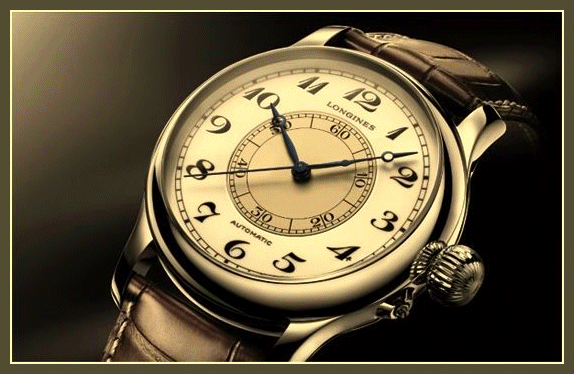
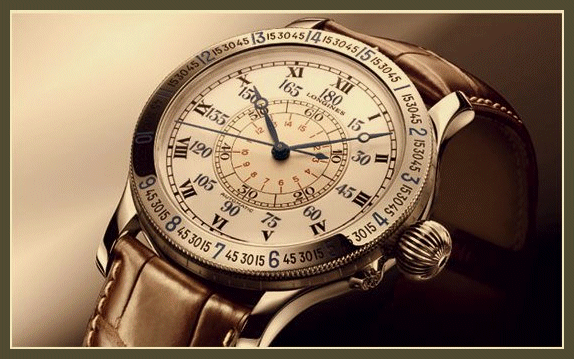
This imposing, yet resplendent timepiece is in stainless steel with a pair of Breguet-style hands and the seconds on a white lacquered dial. The seconds hand is synchronized to a radio time signal via the silvered rotating centre dial with its black painted double minute track and red numerals. The blue and black Arabic numerals engraved on the case’s rotating bezel serve to adjust it to daily variations in the equation of time. The watch is completed by a hinged back cover which can be lifted to reveal a sapphire caseback.
Two brilliant additions to the magnificent Longines collections, but then we have come to expect that from them, just as we expect aviators to be lusting after their watches.
Source: Europa Star April-May 2007 Magazine Issue
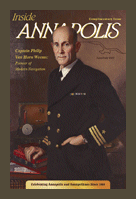
Charles
Lindbergh
In
May 21, 1927, Charles A. Lindbergh completed the first solo non-stop
transatlantic flight in history on the "Spirit of St Louis." The
3,610-mile journey between New York and Paris took a mere 33 hours and
30 minutes. This historic event not only propelled Lindbergh to the
status of a world hero, but also established to the world that air
travel was safe and efficient. Aircraft industry stocks, along with
general interest in aviation skyrocketed.
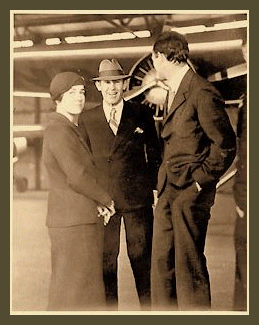
The conversation lasted only a few minutes and Weems thought he would not hear from Colonel Lindbergh again. But, within a year, President Calvin Coolidge's office sent Weems new orders to report to Washington immediately to work with Colonel Lindbergh for a series of instruction on navigation. Weems began training "Lindy." And they developed a mutual respect that led to Lindbergh endorsing the Weems System of Navigation.
Frederick
J. Noonan
Fred
Noonan was hired as a Chief Navigator for Pan Am in 1925 and developed
his skills at the Weems School of Navigation. From 1925 until 1936,
Noonan surveyed and charted courses for the Pan Am fleet of Flying
Clipper Ships. Noonan, using the Weems System, played an important role
in permanently changing the world's concept of time and space and
opening up international air travel for the public.
"Wrong-Way"
Corrigan
In 1938, early aviator Douglas Corrigan requested permission to emulate Lindbergh's historic trans-Atlantic flight in his own plane, but authorities denied his request claiming the plane was overweight for take-off. After secret preparations, Corrigan took off from New York claiming he was headed back to California. Twenty-three hours and 13 minutes later, Corrigan landed in Dublin. Ireland. Tongue-in-cheek, Corrigan proclaimed "I flew the wrong way. My compass got stuck."
This
navigation mistake gained him the nickname "Wrong-way Corrigan,' and
rewarded him with fame - from a ticker tape parade down Broadway, to a
book and a movie deal.Throughout
his life, Corrigan maintained that his Atlantic flight was the result
of faulty navigational techniques. But he clearly knew what he was
doing. Weems had developed a navigationally responsible flight plan for
Corrigan when he began his quest for flying the Atlantic in 1936.
A
groundbreaker in aerial navigation, Australian Harold Gatty flew with
and worked for many of the great names of aviation's golden age.
By
Terry Gwynn-Jones
After
26 hours in the air, the elegant Emsco monoplane City of Tacoma
was in the clouds somewhere off the coast of Japan, returning to
Sabishiro from an unsuccessful attempt to span the Pacific Ocean.
Glimpsing a small break below, the airplane's exhausted pilot, Harold
Bromley, dived steeply. When the plane finally broke into the clear
only a few hundred feet from the ocean, it was headed straight for a
steamship. "I don't know who was more scared—the people on the ship or
me," the Emsco's navigator, Harold Gatty, recalled. Moments later, the
airmen sighted the lighthouse they had passed the previous day, shortly
after taking off from a nearby beach. Their gallant attempt to become
the first to fly nonstop across the Pacific came to an end as they
landed on the beach.
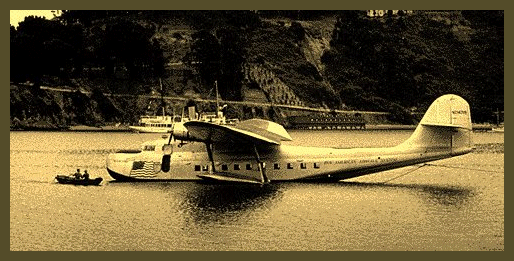
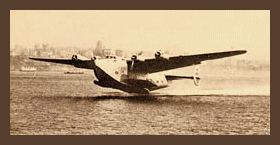
Gatty's
interest in navigation went back to 1917, when he was appointed a cadet
midshipman at the Royal Australian Naval College at age 14.
Surprisingly, his academic career was lackluster, particularly in
navigation. When World War I ended in 1918, Gatty was discharged from
the service. Bent on a career at sea, he joined the Australian merchant
navy as an apprentice (cadet officer) on a steamship plying the route
between Australia and New Zealand. While standing watch at night, Gatty
studied the stars. In the log he kept for many years, he wrote: "I
suppose my imagination was appealed to by the stars and the moon which
play such an important part in navigation. I spent many nights watching
the stars. I soon reached a stage where I could tell the time by the
position of the stars in the heavens. I learned the changes in their
positions in the various seasons of the year."
He
eventually gained a second mate's ticket and served on several ships,
including an oil tanker that sailed regularly to San Luis Obispo,
Calif. Australia was plagued by recession after the war ended, and
Gatty tried many jobs—skippering a cutter, working as an able seaman
and running a waterborne shop in Sydney Harbor, delivering supplies to
naval ships.
In
the early days, Gatty mostly taught marine navigation to yachtsmen.
Toward the end of 1928, however, his interest focused on aerial
navigation—probably spurred on by the recent, highly publicized
transpacific flight of Australian airmen Charles Kingsford-Smith and
Charles Ulm in the Fokker trimotor Southern Cross. In Gatty's
eyes, the key performer in this pioneering flight would have been Harry
Lyons, the American ship's navigator, who kept the Fokker on course to
its tiny island stepping stones.
Gatty
perceived a promising future in devising and teaching a formal method
of air navigation. His plan was to cater, in particular, to the needs
of pilots making long overwater flights, where the aviator's
traditional method of map reading by identifying features on the ground
was no use. He realized that such training could well have saved lives
in the disastrous 1927 Pacific Air Race, when three planes carrying
seven fliers vanished while flying from California to Hawaii. One of
his first students was Arthur "Art" Goebel, the winner of that tragic
race.
Gatty
eventually collaborated with Lt. Cmdr. Philip Charles Weems, a
brilliant U.S. naval officer who had a navigation school in San Diego
that taught the use of precalculated position lines called Weems
curves. That technique had been used by Lindbergh, as well as by
Admiral Richard Byrd and Hubert Wilkins on their polar flights. Gatty
and Weems had much in common and enjoyed working together. The system
they developed led to Weems' generously declaring that Gatty "has done
more practical work on celestial navigation than any other person in
the world today."
Weems
also enlisted Gatty as an instructor, so in addition to running his own
school, the Australian drove regularly to San Diego to teach. When
Weems was assigned as a navigation instructor at the U.S. Naval Academy
at Annapolis, Gatty became manager of the San Diego school.
In
addition to his teaching and navigational skills, Gatty was a prolific
inventor. His first invention was an air sextant that used a spirit
level to provide an artificial horizon. Next he produced an
"aerochronometer" that offset the inaccuracies that aircraft speed
produced when a flier was taking a navigational observation. His most
important contribution, however, was the Gatty drift sight, which he
refined into a superb ground speed and drift indicator widely used by
airmen during the late 1930s and eventually sold to the U.S. Army Air
Corps.
In
1929 Gatty was approached by Roscoe Turner, then the operations manager
for tiny Nevada Airlines, which operated Lockheed Vega monoplanes
between Los Angeles, Las Vegas and Reno. To help promote the company as
"the fastest airline in the world," Turner was planning a flight
between Los Angeles and New York, intended to prove the feasibility of
a fast intercontinental passenger service.
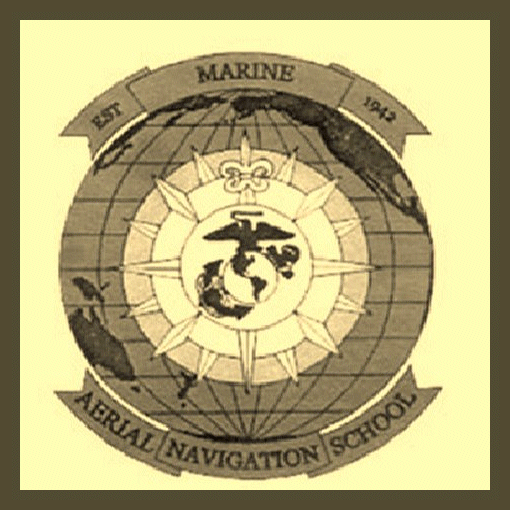
HISTORY OF
MARINE AERIAL NAVIGATION SCHOOL
In May
of 1919, eight years before Lindberg’s famous solo flight, three small
planes set out from Newfoundland headed for London in an attempt to
make the first trans-Atlantic flight. Only one of them made it.
Twenty-five hundred feet below on board a station tracking ship, a
young navigator, Lt. Cdr. Weems, U.S. Navy, gazed up and thought there
must be a safer and simpler way of aerial navigation. Weems taught
navigation at the Naval Academy in the 1920’s and went on to establish
his own school in Annapolis to teach The Weems System of Navigation.
Charles Lindberg studied with Weems before attempting his
trans-Atlantic flight. Admiral Byrd, a classmate of Weems at the Naval
Academy, came to Weems for
instruction before setting out for the North Pole. As did many others.
The Marine Corps came in 1942 when it assigned five Marine officers to
the school and established the Aerial Navigation School at the Weems
School of Navigation.
In the
earliest days of aviation, the military had little need for aerial
navigators because their planes had limited range and capability. For
the Marine Corps, that need did not exist until the advent of the
Douglas C-47 (R4D). Formed in March of 1942, VMJ-253 was the pioneer
squadron of Marine Corps aerial transportation as well as the parent
squadron for the joint air transport organization dubbed the South
Pacific Combat Air Transport Command (SCAT). Crews were quickly formed
and ordered to report to the Douglas Aircraft Company in Santa Monica,
California to begin training on the new aircraft. Working with the
aircraft engineers, they helped design an area of the aircraft for the
navigators compartment. The first aerial navigators were recruited from
some of the existing pilots and crew chiefs and trained by the U.S Navy
at NAS North Island, California. By November of 1942 they had already
supported combat operations on Guadalcanal and moved to Camp Kearney in
Mesa, California in late 1942. A year later the school was on the move
again, this time to MCAS Cherry Point, North Carolina, where
they graduated their first class of navigators in January of 1945.
However, this training program existed only as a ground school and was
deactivated in March 1948.
In March
1952, after the beginning of the Korean conflict, the Aerial Navigation
School was reactivated as part of the Airborne Operators Schools (AOS),
located at MCAS Cherry Point, North Carolina. The AOS consisted of the
Aerial Navigation School, the Radio Operator School and the Electronic
Countermeasure (ECM) School. During this time, Marine navigators
trained in such aircraft as C-54’s, R4D-6’s (C-478), and R4D-8’s (Super
DC-3). The Aerial Navigation School remained at Cherry Point until
January 1971, at which time it was moved to NAS Pensacola, Florida,
when the Navy assumed responsibility for the flight support. A
detachment, VT -29, of T -29 aircraft from NAS Corpus Christi which had
been previously assigned for Navy support, now provided flight support
for the Aerial Navigation School at Pensacola. At this point, the name
of the school was changed to the Marine Aerial Navigation School
(MANS). After two years at Pensacola, the Navy moved the detachment of
T - 29’s and MANS moved to NAS Corpus Christi in order to continue the
T -29 flight support. Finally, due to the phasing out of the T -29’s at
Corpus Christi, the school moved once again in 1976 to Mather AF8,
California and joined with the U.S. Air Force. MANS operated as a
separate organization at Mather, with the only Air Force contact being
the sharing of the sophisticated facilities, the T -43 aircraft, the T
-45 simulator, the Navigation Procedures Laboratory, the Planetarium
and the Learning Center. The school remained at Mather for 17 years and
in January of 1993 made it’s final move to Randolph AF8, Texas.
During the past 62 years
MANS has supplied the worlds finest aerial navigators in support of
Marine Corps aviation. Presently, there are approximately 115
active-duty Marine navigators. Over the years the school has furnished
navigators for aircraft such as the R5C (C-46), R4D (C-47), P84Y-2
(single tail 8-24), P8J (8-25), R4Q (C-119), R5D (C-54) and currently
on the KC-130 F/R/ T.
Marine instructors utilizing the 12th
Flying Training Wing navigation training facilities staff the Marine
Aerial Navigation School. The mission of MANS has been to train and
qualify enlisted Marines in the “Science and Art of Navigation” as
navigators aboard tactical transport aircraft in support of Fleet
Marine Forces.
The Story of Weems & Plath

Long before the
invention of the satellite Global Positioning System, sailors traveled
the seas with little more than the stars and sun and courage to guide
their journeys. Captain Philip Van Horn Weems, a 1912 graduate of the
U.S. Naval Academy, focused on improving navigational techniques and
devices.
In 1919, Weems was promoted to Lt. Commander
and assigned to the destroyer USS O'Brien. Weems and the crew of the
O'Brien were a part of a historic transatlantic flight in May of that
year. The NC-4 Curtiss Flying Boat crossed the Atlantic Ocean from May
16 to 27, guided by 20 ships at 50-mile intervals along the route.
Weems was one of the Navigators charged with calculating his ship's
exact location, and thus helping to guide the aircraft across the vast
waters.
Weems realized, however, that attempting to
navigate a plane by sight alone was fraught with difficulties,
including fog and cloud cover. While ships didn't rely on landmarks,
but on complicated calculations based upon celestial bodies, air crews
could not spend the time working out difficult computations. Even then,
in the early days of navigation, planes just went too fast.
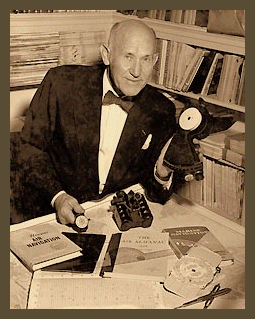
While teaching navigation at the Naval
Academy from 1924 to 1927, Weems continued to think about air
navigation. An illness laid him up for a while, and he took advantage
of his recuperation as a time to complete his work. The Weems System of
Navigation used the same calculations that had always guided ships, but
organized these calculations (already computed) into an easy-to-read
table. By eliminating much of the work of making these calculations,
navigation could be done faster and more accurately. He also invented a
special watch—the Second Setting Watch—for the accurate determination
of Greenwich Mean Time, a particularly important part of celestial
navigation. He even made modifications to that old stand-by, the
sextant, making it a faster and more reliable instrument as well.
With the help of his wife, Weems began to
market his system. He provided correspondence courses and sold
navigational instruments, and later was sent on an official mission to
Washington , D.C. to train Colonel Charles A. Lindbergh in the Weems
System of Navigation for his upcoming round-the-world flight.
In 1933, Weems retired from the Navy, but
continued his work in navigation. He moved his company back to his
hometown of Annapolis , and in 1961, at the age of 71, he was called
back to active duty in order to teach four young ensigns about space
navigation.

The story of Weems & Plath began when
Weems established his company. The Plath half of the company's name
refers to C-Plath, a German maker of fine commercial sextants and
magnetic compasses. By 1953, a working relationship with Weems had been
established to market and sell C-Plath's array of high quality marine
instruments.
Peter Trogdon, president of Weems & Plath
today, was introduced to the company about 12 years ago when he worked
for what is now known as Northrop Grumman. The company had acquired
Weems & Plath, and placed it in a division managed by Trogdon. A
couple of years later, when the division was being divested, he was
able to negotiate the purchase of Weems & Plath.
“It just happened that when it came for sale
that it was something I was passionate about,” he explained. “I have a
real love for the products, and what we're doing here, and the people
that are here.”
Though the company could be located almost
anywhere on the planet, “these people we have here are so
knowledgeable, so dedicated,” he continued. “We're not just a warehouse
where there's product in, product out. There's a lot of production work
going on, and talent about servicing and repairs, as well as assembly,
and people who know how to buy this and know what they're buying. It
would be far riskier to take this away from here. We're close to our
customers. They walk in all the time.”
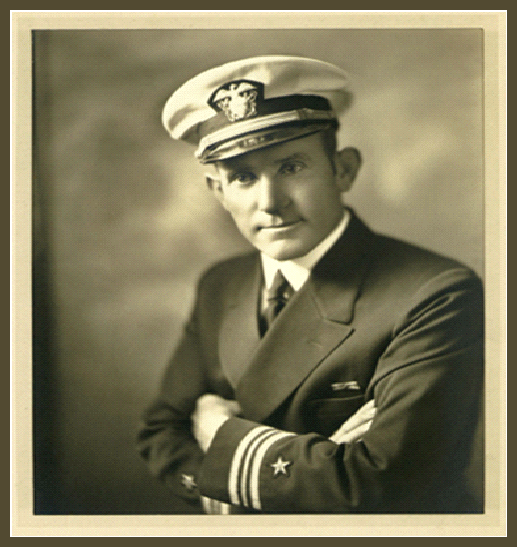
Today, the company produces a full spectrum
of precision marine instruments for pleasure boaters, commercial
vessels, cruisers, serious yacht racers, and the military. These
include brass nautical clocks and barometers, navigation tools,
high-end oil lamps, Imray books and charts, binoculars, children's
books, and more.
“If someone wanted an oil brass lamp for
their home, or a nautical lamp for their boat or their home,” Trogdon
said, “we probably have 250 to choose from. Nobody has that kind of
[selection]. That's just what we do.”
Navigation tools sell the most units, and
expensive clocks and barometers are biggest sellers in terms of
dollars. The company's beginnings were rooted in navigation
tools—parallel rules, plotters, etc. “We're selling these more than
ever,” he said. “We sell hundreds of thousands of navigation tools
every year.”
Trogdon said it is a niche business, and
“we're really big at what we do. There's probably no one in the world
that sells as much of this stuff as we do, and has been doing it as
long as we have. We're the largest traditional navigation tool
manufacturer.”
With a staff of 25 employees, Weems &
Plath offers few overt clues of its multinational clout. The company
has factories and distribution channels scattered all over the globe.
Its humble Eastport facility consists of administrative and sales
offices, a small workshop, and a relatively large storage area for the
shipments of parts and products from overseas.
Weems & Plath has two main places where
products are made—Europe and Asia . In Europe, they come mostly from
Germany and Switzerland , with some from Denmark and Italy . “These
companies are older than we are—over 100 years,” Trogdon noted.
“We have a core of products coming from both
China and Taiwan ,” he continued. “It's not always about cheaper. We're
trying to get the best value. We're always trying to get the highest
level of quality. The labor is cheaper, but the quality is real high.
These metal workers are really good. So, we've got our tooling there,
and we design our products in conjunction with them.”
Weems & Plath sells through boat supply
retailers. “We have about a thousand stores we sell to,” he said. “Some
of them order hundreds at a time.” Primarily located near salt water,
locations of stores include “everywhere in California and down through
Mexico and a few places in Chile . We do foreign navies and coast
guards, commercial fleets, and a lot of yacht businesses.”
The company has a large stockpile of parts.
“We can service anything back about 20 years,” Trogdon noted. “Most of
our products have a lifetime warranty, so we'll take care of it.”
Yet Weems & Plath continues to look
forward, even as they maintain older products. “We do design work here,
and we have engineering staff that we use in different places to help
us,” Trogdon said. “We also have inventors come to us with their ideas.
There's pretty significant opportunity for innovation. We come out with
about 15 to 20 new products every year.”
Weems & Plath has a New Product Committee
consisting of key people who review all ideas for new products. “Every
month we sit down with the committee, and we have a list,” Trogdon
explained. “Some of those products never get made. They're on that
list. They're ideas. Some move right to the top quickly, and some take
years. Some get done and nobody wants one, and that's a total failure
on our part because we put it through all these steps. Ninety percent—9
out of 10—are successful. Some are successful for a lot of years, and
some are successful for a shorter period of time, for whatever reason.
Obviously, our goal is for a product that really performs and lasts a
long time, and has a great track record in terms of sales.”
The market for navigation tools? “The primary
market for this will be the yachtsman,” he said. Day sailors who are
always in sight of their port do not do a lot of navigating. “They just
try to avoid the shallow water.” Navigation is important for longer
excursions, especially to unfamiliar areas. “Most people today have
GPS, but they have paper charts as a backup. You can locate your GPS
position on the paper charts using these tools.”
Weems & Plath also provides a customized
engraving service. “This has been a huge benefit to the company,” he
said. “Yacht clubs and corporations want a nautical gift, but they want
it customized. We're doing a lot of that. People come from the
neighborhood, all the churches come, the city, and the Naval Academy
—with all kinds of projects.”
The marine instruments business is very
dynamic. “There are new factories to see,” Trogdon explained. “There
are new products coming out. There are new markets to go after—like the
corporate market, the engraving market. Our sales overseas are growing.
We're trying to do more and more business overseas throughout the
product range. I'm traveling into Europe to expand our sales efforts,
and visiting factories at the same time to try to get better
production, better quality, better finishes, better accuracy.”
He continued: “There's the dynamic of having
25 people managing the brand, trying to get the sales out the door,
with no mistakes in shipping, at the right price. The people buying it,
do they see the value and are we selling it at the right price? There's
always constant change. To think that you can sit still and rest is the
beginning of the end.”
Trogdon concluded: “For me, it's how hard do
I want to push myself? You gotta create some balance. I ride my bike to
and from work most of the year, from Severna Park , because the fresh
air and exercise is a great thing.”
Contact:
Peter Trogdon, President
Weems & Plath, Inc.
214 Eastern Avenue
Annapolis , MD 21403
Web: http://www.weems-plath.com
Email: trogdon@weems-plath.com
410-263-6700 x16
In May of 1919, eight years before Lindbergh's famous solo
flight, three small planes set out from Newfoundland headed for London
in an attempt to make the first transatlantic flight.
Only one of them made it.
Twenty-five hundred feet below on board a station tracking
ship, a young navigator, Lt. Cdr. Philip
Van Horn Weems, U.S. Navy, gazed up and thought there must be
safer and simpler way than using a small armada of ships as beacons for
the flight.
As a recreational boater, you may ask, what does this have
to do with me?
For centuries, man
has relied on the stars, circling planets and the constant horizon to
guide him in his travels. A compass, sextant and charts were the
necessary tools for plotting a course. However, due to lengthy
computations and the space needed for large charts, the timeworn system
of celestial navigation was ill suited to the airplane cockpit.
Weems, a brilliant, inventive and determined young man knew
as he tracked that first flight that navigation was his destiny. He
went on to revolutionize the field with his ideas, writings and
inventions. Whether you have traveled across a lake, sea or skies,
chances are you have benefited from his contributions to navigation.
In the early 1930s, Capt. Weems was widely credited with
vastly improving navigational techniques which were in essence,
unchanged since the early 1800s. When an accurate timepiece was needed,
Weems invented the Second Setting Watch with its inner rotating dial
that allowed the second hand to match the dial perfectly. This made
finding Greenwich Mean Time (GMT) easier --a critical step for
celestial navigators, as miscalculating the seconds in GMT could mean
the difference between life or death.
1889-1979
P. V. H. Weems, internationally known air navigator, was born March 29,
1889, at Turbine, the son of Joseph Burch and May Elizabeth Rye Weems.
He attended Walnut Grove Country School in Montgomery County and
Branham and Hughes School in Spring Hill before receiving an
appointment to the U.S. Naval Academy at Annapolis in 1908. While at
the academy, Weems excelled in crew, football, boxing and wrestling,
winning a place on the 1920 U.S. Olympic wrestling team. He graduated
in 1912 and was commissioned an ensign in the U.S. Navy. He married
Margaret Thackray in New York in 1915.
In 1927 Weems served with the Aircraft Squadron Battle Fleet, began
research in air navigation, and published Line of Position Book. From
1928 to 1930 he served as executive officer on U.S.S. Cuyama and wrote
the textbook Air Navigation (1931), which received international
acclaim and won a gold medal awarded by the Aero Club of France.
In addition to his military career, Weems established with his wife the
Weems School of Navigation (1927). He perfected his air navigation
system by simplifying the method of determining latitude and longitude
by aerial observations, improving sextants, and adapting chronometers
to air use. He taught air navigation to Charles Lindbergh and assisted
in the aviator's global flight to determine commercial airways for Pan
American Airways. In 1933 Weems went on the naval retired list and
devoted his energies to further perfecting his navigation system. That
year he designed the first Air Almanac. Two years later he patented the
Mark II Plotter and published Marine Navigation and Star Altitude
Curves.
Weems returned to active duty in 1942 and won a Bronze Star for his
service as a convoy commander. He was promoted to captain and received
the wings of Naval Air Navigator in 1945. He retired from active duty
for the second time in 1946.
As he had earlier, Weems continued his private career in air
navigation. In 1960 the American Institute of Navigation awarded Weems
a gold medal in honor of fifty years of outstanding achievement in air
navigation. As the space age got underway Weems taught a pilot class in
space navigation at the U.S. Naval Academy (1961-62). Weems furthered
knowledge of the world through his mapping and navigation research. His
papers are preserved at the Tennessee State Library and Archives.
Pleasant
Plains Farm
Annapolis,
MD
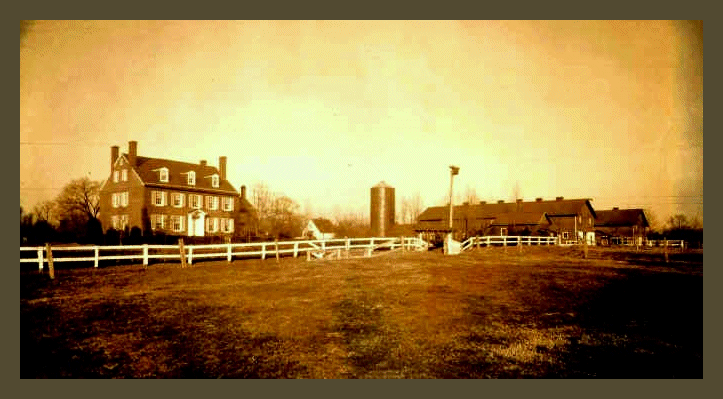
Pleasant
Plains Farm (circa 1920) -- owned at the time by the Kaiser Family.
The
Pleasant Plains area was originally part of Providence, the first
European settlement in Anne Arundel County, which was founded in December
1649. Situated on the south side of Ridout Creek, Pleasant Plains Farm
once encompassed more than 700 acres, and was originally settled and
farmed in the mid-17th century. The main house at Pleasant Plains Farm
is thought to have been built by John Ridout about 1830. John Ridout,
son of Horatio Ridout, was the grandson of John Ridout—who was
secretary to Governor Sharp—and nephew of Orlando Ridout (I).
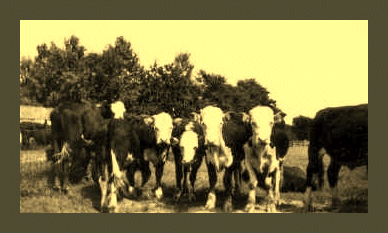
The
farm was purchased by the Weems family in the 1940s. On the untimely
death of Lt. Cdr. George T. Weems in a plane crash, his father Capt.
P.V.H. Weems transferred the south portion of the farm in trust for his
grandson Philip V.W. Dodds in 1951, and the north portion to his
granddaughter Thackray Dodds Seznec.
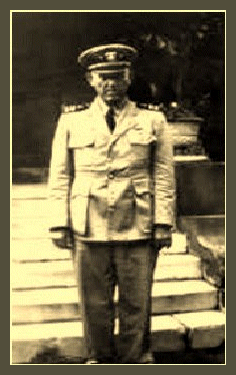
Capt.
P.V.H. Weems manged the farm in the 40's and early 50's.
Philip’s
father, Capt. Charles Dodds, retired from the Navy in 1957 and moved
the family to the farm. For the next 25 years, Pleasant Plains was a
full working farm with—among other things—hogs, cattle, corn, oats,
hay, and horse boarding. When the two large barns on the property
burned, the fields were leased to a turf operation and Capt. Dodds
retired.
Capt.
and Mrs. Dodds continued to live at the farm until Mrs. Dodds died in
1998. During 1999, Philip and Susan Dodds began the restoration of the
house and surrounding buildings then moved back to the farm on
completion.

Capt.
Dodds and Bob Hunteman, late '60s -- father nearly always wore a tie.
Many
people still recall the wonderful “gatherings” at PPF over the past 45
years, full of music, poetry and art. Charlie Dodds frequently played
his accordion and sang old Navy songs, while others brought guitars,
banjos and basses to play bluegrass, barbershop, and blues. Meanwhile,
Missy Weems Dodds, a locally well-known and accomplished artist,
evolved her unique impressionistic abstract style in her studio in the
north parlor. (The Dodds’ still have the majority of her works and are
planning a retrospective exhibition in the near future.
Restoration
The farmhouse, however,
proved to be more of a challenge than the Bordley-Randall house. Mindful of the Show House
deadlines, demolition began in late 1999, and the majority of
structural work was completed early in 2000. Working from the top down,
the interior walls were refurbished, replastered, and new mechanical
services installed. It is expected that the interior work will be
completed by mid-year 2000; the Auxiliary has use of the premises
starting August 2000. (Upper Left) Sue Dodds, with cell phone clipped and plans in hand inspects the third floor. (Right) Philip Dodds works at his old Civil War period plantation desk (which was his desk as a child), now located to the basement for the duration. He does his day job there while while overseeing the work in progress. Nearly complete, but not quite, he plans to finish the restoration of the desk after the show house. (Lower left) Alison Dodds -- note the quite fetching coating of plaster dust on her face -- uncovers well persevered mouse bones. We keep searching, but no treasures have turned up between the walls so far. Sigh. |
Pleasant Plains Farm Restoration

Before
the invention of the Global Positioning System, or GPS, Captain Philip
Van Horn Weems modernized the art of celestial navigation by
simplifying techniques and inventing time saving methods.
The
genius of this 1912 graduate of the Naval Academy has touched all types
of navigation -- from maritime to aviation, from underwater to outer
space.
Delve
into the world of this renowned Annapolitan and see how he paved the
way for 21st century modern navigation, letting us take knowing exactly
where we are… for granted.
Maritime
Institute of Technology Hosted a Reception
to Mark
Opening of Annapolis Maritime Museum exhibit
Thursday,
June 9
The
Annapolis Maritime Museum exhibit “Before GPS: the Genius of Captain
Philip Van Horn Weems, 20th Century Navigation Pioneer,” is currently
on display at the Maritime Institute of Technology and Graduate Studies
(MITAGS). An evening reception to promote the exhibit was ehld on
Thursday, June 9, 2005, at MITAGS’ Linthicum campus. Philip Van Horn
Weems Dodds gave a special presentation, which detailed his
grandfather’s remarkable career as a navigator, educator, and
entrepreneur.
MITAGS
teaches state-of-the-art maritime training (including navigation) to
mariners from around the world. In addition to its educational
curriculum, the MITAGS facility also supports a full-service conference
center and numerous displays that chronicle the role of merchant
mariners throughout history.
The
Weems exhibit was introduced by the Annapolis Maritime Museum in the
summer of 2003. However, its availability for viewing at the museum was
short-lived due to the devastation that was caused by Hurricane Isabel.
Fortunately, volunteers were able to retrieve the exhibit.
For
additional information on the Maritime Institute of Technology and
Graduate Studies, please call admissions toll-free at 866 656-5568. You
may also visit the MITAGS website at www.mitags.org.
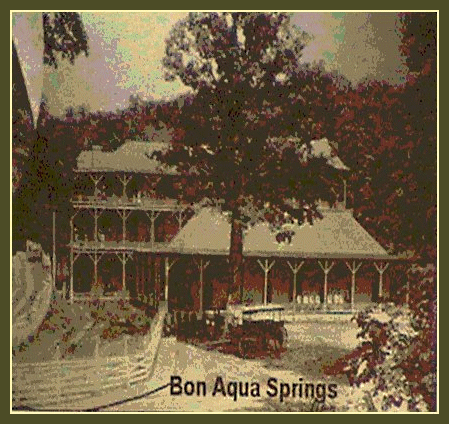 ]-->
]-->
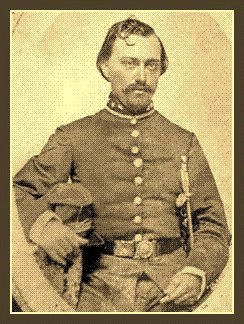
Two Men in a Hurry
Time magazine
He was where he was because,
after an excellent record as testpilot for the Lockheed factory, he got
a job as aerial chauffeur for Frank C. Hall, onetime drug clerk who
struck a fortune in Oklahoma oil. In this same plane, named for the
oilman's daughter Mrs. Winnie Mae Fain,
Post won the Los Angeles-Chicago air derby last year. Then Hall
financed him for the attempt to break the round-world record of the Graf Zeppelin—21 days, 7 hr.
Busier than Pilot Post as the
Winnie Mac streaked over the water was Harold
Gatty. Cramped into a tiny space behind a wall of special fuel
tanks he alternately poked his sextant through a port in the roof,
scribbled his computations, passed written directions to the pilot, and
pumped gasoline up into the wing tanks. Hard work, but nothing compared
to the ordeal of last summer when he and Harold Bromley got 1,200 mi.
from Japan in an attempt flight to the U. S. and then had to fight
their way back to shore with a broken exhaust ring spewing carbon mon-
oxide gas into the cabin. That put him in a hospital for two months.
This navigating business had been his forte since he entered the Royal
Australian Naval College at 13. For many years he was a mariner, then studied aerial
navigation under famed Lieut. Commander Philip Van Horn Weems U. S. N.,
later taught the Weems system, instructed Mrs. Charles Augustus
Lindbergh at request of her husband.
Time
magazine hilip
Van Horn Weems, Forrest
DIED.
Philip Van Horn Weems, 90, navigation expert; of pneumonia; in
Annapolis, Md. A Tennessee farm boy who graduated with the same U.S.
Naval Academy class ('12) as Explorer Admiral Richard Byrd, Weems
developed many navigational methods and devices, among them the Weems
plotter, treasured by pilots from World War II on. An adviser to Byrd and Charles Lindbergh,
Weems was often called back to duty after retiring as a Navy captain in
1933, the last time to devise an instrument allowing astronauts to find
their way without using computers.No
Who invented the Global Positioning System?

by
Richard Easton
Monday, May 22, 2006
Alexander
von Humboldt observed that there are three stages in scientific
discovery: first people deny that it is true; then they deny that it is
important; finally they credit the wrong person.
—cited in A Short History of Nearly Everything, by Bill Bryson,
p. 421
Arguments are rife over
priority in major scientific and technological advances. An example is
the role of Newton versus Leibnitz in the development of calculus.
Another is the controversy over Langley versus the Wright Brothers in
the airplane. For many years, the Smithsonian put forth the claim of
Langley, its former head, and the Wright Brothers boycotted it.
(Captain Philip Van Horn Weems, who helped resolve this controversy,
played a major role in aviation navigation and later played a
peripheral role in the developments recounted below.) The Smithsonian
dropped its claim about Langley and Orville Wright allowed the
Smithsonian to exhibit the Wright planes. Similarly, the origination of
the Global Positioning System (GPS) is in dispute.
tePhilip
Van Horn Weems Papers, 1833-1965. 31 linear feet. TSLA.
Genealogical
data on the following families includes Atlee, Barber, Carmichael,
Haldeman, Jenkens, Riegard, Rush, Robbins, Chapman, Hagewood, Lansdale,
Lock, Pearson, West, Phillips, Van Horn Weems, and Weems’ kindred
families.
An
1857-1861 diary and account book kept by a medical doctor in Tennessee,
Thomas H. Rye, gives information such as medical fees at the time.
There
are thirty diaries which cover the years 1911-1963 intermittently, the
heaviest concentration of which is during the years when Weems was a
Midshipman at the U.S. Naval Academy
Weems
Family Interviews, 1973. 5 reels. TSLA.
http://www.tennessee.gov/tsla/history/manuscripts/findingaids/94-174.pdf
The Weems Family Interviews collection consists of taped interviews
with various members of the Weems family. The Weems family was
originally from Tennessee, but most members of the family settled in
Maryland, which is where the interviews took place. The interviews
concentrate on the life of Phillip Van Horn Weems, a noted inventor and
aviator. Phillip Van Horn Weems was known for creating various
instruments that were used as navigational aids by pilots, as well as
authoring several books regarding aviation. Additionally, the
interviews talk about other family members and the various activities
associated with their lives.
Please
note, this collection is housed in the cold storage vault. Please allow
24 hours for tapes to acclimate before using this collection.
A Short
History of C.PLATH
The C.Plath
company was originally founded in Hamburg in 1837 by David Filby, son
of an innkeeper in Husum on the west coast of Schleswig-Holstein in
North Germany. David Filby traded in nautical literature, charts and
sextants imported from England.
|
|
Ebony octant with ivory
inlay bearing the inscription: D. Filby
Hamburg. Ca. 1840 |
Carl
Christian Plath, to whom David Filby sold his highly reputable business
in 1862, was born on Christmas Day in 1825. His father was the pastor
of the Michaeliskirche in Hamburg "New Town", a church known to seamen
all over the world as the "Hamburger Michel". On leaving school he
began an apprenticeship as an instrument maker in Hamburg. After
completion his apprenticeship, Carl Plath, following the custom of the
time, went on his travels to Berlin, Vienna, Prague and Munich before
he set up a workshop for the production of surveying instruments in
1857.
|
|
Carl Plath
with his family. Extreme
right, the young Theodor Plath |
When Carl
Plath purchased Filby's business in 1862 he sold his own business to
his former employee J. C. Dennert. With his new business Carl Plath
concentrated on the manufacture of sextants, magnetic compasses,
binnacles and barometers. In August 1887 Carl Plath was awarded a
German Reich Patent for his newly developed compass card.
|
|
The
Herrerngraben Canal overlooked by the back of the Plath business
premises, Stubbenhuk 25 |
In 1882,
three years after Filby's death, Carl Plath sold the nautical
literature and charts department of the business to the newly
established firm of Eckardt & Messtorff, a bookshop which still
exists today.
Carl Plath
was awarded the Gold Medal at the Hamburg Crafts and Industry
Exhibition in 1889 for his nautical instruments, in particular for the
excellent precision work.
Also in 1889
Carl Plath's son, Theodor Christian Plath, born in 1868, became
co-owner of the company.
Carl and
Theodor Plath exhibited a collection of nautical instruments in the
Pavilion of the German Shipping Exhibition at the Paris World
Exhibition in 1900 and were awarded the Silver Medal as mark of the
highest distinction for nautical instruments in commercial shipping.
|
|
Silver Medal,
engraved with the firm's name 'C.Plath', awarded by the Prize Committee
of the Paris World Exhibition in 1900 |
In 1905 at
the advanced age of 80, Carl Plath retired. Three years later he handed
over his share of the business to his son Theodor, who with effect from
30th April, 1908 became sole owner of the firm C.Plath.
|
|
Theodor
Christian Plath |
|
|
C.Plath
standard sextant, ca. 1885 |
|
|
A boat
compass built by C.Plath at the turn of the century |
The
"Sun-Shooter" trademark was registered on 23 October, 1905 and
published in the Trademark Gazette of the Imperial Patent Office of
March 1906.
|
|
Trademark
Gazette of the Imperial Patent Office of March 1906 with the registered
trademark of the Sun-Shooter of 23 October, 1905 |
Dr Hermann
Anschuetz-Kaempfe was granted a patent for the first gyrocompass in
1905 and this new development was closely followed by Theodor Plath,
and it was no surprise when in 1912 C.Plath became a sales and service
agent for Anschuetz for the merchant marine market, whereas Anschuetz
concentrated its efforts on the German Imperial Navy. This business
relationship came to an end when the German Reich collapsed at the end
of World War II.
|
|
The
four-screw steamer Imperator of the Hamburg-America Line was in 1913
the first merchant ship in the world to be equipped, on Theodor Plath's
initiative, with a gyrocompass system. Here seen leaving the port of
Hamburg on it's maiden voyage. |
Theodor's
only son, Johann Christian, died at the age of only 27 in 1929 and
wishing to keep the firm in the family, he handed the business over to
his son-in-law Johannes Boysen in 1937, but only after he, at the age
of 32, had served an apprenticeship as an instrument maker.
|
|
Title page of
the C.Plath catalogue No. 12 with a photo of Captain Wittemann using
the Plath bubble sextant in the airship Graf Zeppelin during its
round-the-world flight in 1929 |
After the end
of World War II, C.Plath turned to alternative products for survival
and started production on a small scale of typewriters, spray guns,
machines for making whipped cream and movements for railway station
clocks. A modest repair service was also set up in the old head office
overlooking the port.
Nevertheless,
C.Plath was dismantled completely by the occupation forces. Between May
1948 and May 1949 a total of 143 machines were confiscated and
dismantled by the occupying powers.
The
relaxation of the various prohibitions in meant that by 1949 C.Plath
could begin again the production of its classic range of nautical
instruments. Also in 1949 C.Plath was offered a gyrocompass patent and
in 1951 the first gyrocompass designed to this patent was presented to
the public. C.Plath had now progressed from the role of instrument
maker to that of a modern marine navigation equipment manufacturer. In
the following years the product range was expanded by many more modern
designs such as autopilots, speed logs, radio direction finders, etc.
|
|
The first
C.Plath gyrocompass KK 51, also known as Type A |
At the
beginning of 1953 Johannes Boysen , together with the well-known
American navigator P.V.H. Weems, founded in Washington the firm of
Weems & Plath Inc., whose main purpose was to step up the sale of
C.Plath sextants in the USA.
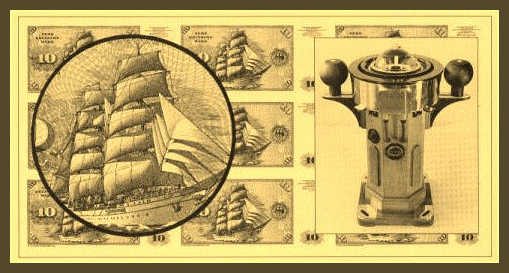
The German
training ship Gorch Foch, built in 1958, which since 1963 has been
portrayed on the ten Mark note, was fitted with a C.Plath magnetic
comnpass system
Theodor Plath
retires from the firm on 31 December 1950 at the age of 82 and gives up
his limited partnership. He died at the age of 91 on 16 February 1960.
In 1962
C.Plath was acquired by Litton Industries, a large American concern
with its head office in Beverly Hills, California. Work was immediately
started on the production of the LN-3 inertial navigation system for
the F 104-G Starfighter for the German Airforce.
C.Plath North
American Division is set up in 1978 in College Park near Washington.
After the end
of the cold war in 1992, the C.Plath production facilities were moved
to sister company Litef in Freiburg in the Black Forest. Engineering,
sales and service remained in Hamburg.
1996 saw the
introduction of the world's first fiber-optic solid-state gyrocompass
by C.Plath. The first ever gyrocompass with no moving parts.
Sperry Marine
was formed in 1997 with the combination of C.Plath, Decca Marine and
Sperry Marine.
After 163
years, C.Plath changes its name to Sperry Marine in May 2000.
In 2001
Sperry Marine becomes part of the Northrop Grumman Corporation.
Pilot of the Winnie Mae
First to Fly Solo Around the World, Lost over Alaska
AcePilots Main Page
The Planes
Aviation
Pioneers
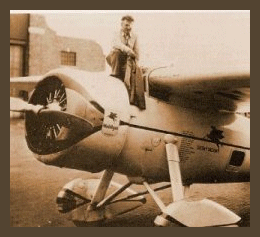
When Wiley Post and Will Rogers crashed at Point Barrow, Alaska on August 15, 1935, the world mourned the loss of the great flier and the beloved humorist.
Post twice set the record for flying around the world:
- June, 1931 - 8 days, 16 hours - with navigator Harold Gatty
- July, 1933 - 7 days, 19 hours - solo
Winnie Mae
(When I was a child, my Dad, a lifelong aviation buff, had a model of the Winnie Mae in the house. It's weird aerodymanic 'pants' over the wheels fascinated me, as did its blue-on-white color scheme, its large NR-105-W registration number on the wings, and the list of faraway cities on its world itinerary.) In 1930, the Lockheed Vega was the hottest airplane of its type. Specifications and performance data for the "Wasp" powered Lockheed Vega 5-C:
length 27'8", wing span 41', height 8'6", wing area 275 sq. ft,
empty weight 2361 lbs., useful load 1672, payload 1012, gross wt. 4033 lbs.,
max. speed 170 MPH, cruise 140 MPH, landing 54 MPH, ceiling 20,000 ft.,
gas capacity 96 gal., oil 10 gal., range 725 miles.
price at the factory, July 1928 - $18,500.
In addition to Wiley Post, two female aviators, Amelia Earhart and Ruth Nichols flew the planes.
Post first achieved national prominence in 1930,when he won the National Air Race Derby, from Los Angeles to Chicago. The side of the Winnie Mae's fuselage was inscribed: "Los Angeles to Chicago 9 hrs. 9 min. 4 sec. Aug. 27, 1930." The Winnie May is on display at the Smithsonian National Air & Space Museum (NASM).
Around the World in Eight Days
On June 23, 1931, Post and Gatty left Roosevelt Field, New York. They made fourteen stops: first at Harbor Grace, Newfoundland; then Chester, England; Hanover and Berlin, Germany; Moscow, Omsk, Novosibirsk, Irkutsk, Blagoveshchensk and Khabarovsk, all in the Soviet Union; Nome, Alaska; and Edmonton, Canada. They then flew to Cleveland, and back to New York on July 1, having traveled 15,474 miles.
Here's their partial itinerary, copied from the program of the July 7 Hotel Astor Banquet.
|
The Graf Zepplin
